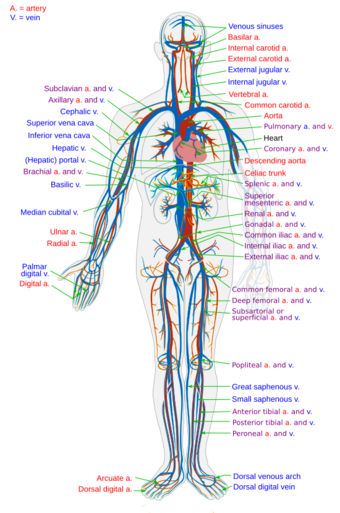Circulatory collapse
Topic: Medicine
 From HandWiki - Reading time: 3 min
From HandWiki - Reading time: 3 min
| Cardiovascular collapse | |
|---|---|
 | |
| Circulatory system |
A circulatory collapse is defined as a general or specific failure of the circulation, either cardiac or peripheral in nature. Although the mechanisms, causes and clinical syndromes are different, the pathogenesis is the same—the circulatory system fails to maintain the supply of oxygen and other nutrients to the tissues and to remove the carbon dioxide and other metabolites from them. The failure may be hypovolemic or distributive.
A common cause of this could be shock[1] or trauma from injury or surgery.[2]
Types
A general failure is one that occurs across a wide range of locations in the body, such as systemic shock after the loss of a large amount of blood collapsing all the circulatory systems in the legs. A specific failure can be traced to a particular point, such as a clot.
Cardiac circulatory collapse affects the vessels of the heart such as the aorta and is almost always fatal. It is sometimes referred to as "acute" circulatory failure.
Peripheral circulatory collapse involves outlying arteries and veins in the body and can result in gangrene, organ failure or other serious complications. This form is sometimes called peripheral vascular failure, shock or peripheral vascular shutdown.
A milder or preliminary form of circulatory collapse is circulatory insufficiency.
Causes
A very large range of medical conditions can cause circulatory collapse.Cite error: Closing </ref> missing for <ref> tag
- Failed heart transplant or artificial heart; in those with cardiovascular disease who are just being treated with medical therapy or oxygen, pacing, cardioversion, or defibrillation using an implantable cardioverter-defibrillator, or else implantation of an intra-aortic balloon pump, or a unilateral or bilateral ventricular assist device, may help matters, as could the use of stenting and/or coronary artery bypass surgery and/or the removal of atherosclerotic plaques. Eventually, a heart transplant or artificial heart may be needed, and these can be replaced when they are no longer performing as well as they did. If necessary, while waiting for a transplant or device, extracorporeal membrane oxygenation (ECMO) or mechanical ventilation using a ventilator, or other less invasive methods, can be used to help compensate. If other systems get impaired, renal dialysis, liver dialysis, and artificial nutrition and hydration (including total or partial parenteral nutrition) can also be used.
- Congenital heart defects
- Obstructive shock
- Distributive shock
- Septic shock
- Anaphylactic shock
- Acute pancreatitis
- Hypotension due to medications
- Intoxicative inhalants[3]
- Combined
Effects
The effects of a circulatory collapse vary based on the type of collapse it is. Peripheral collapses usually involve abnormally low blood pressure and result in collapsed arteries and/or veins, leading to oxygen deprivation to tissues, organs, and limbs.[citation needed]
Acute collapse can result from heart failure causing the primary vessels of the heart to collapse, perhaps combined with cardiac arrest.[citation needed]
Diagnosis
Treatment
References
- ↑ http://www.spaceref.com/iss/medical/4044.shock.circ.collapse.em.pdf [bare URL PDF]
- ↑ Alten, Jeffrey A.; Moran, Ana; Tsimelzon, Anna I.; Mastrangelo, Mary-Ann A.; Hilsenbeck, Susan G.; Poli, Valeria; Tweardy, David J. (2008). "Prevention of Hypovolemic Circulatory Collapse by IL-6 Activated Stat3". PLOS ONE 3 (2): e1605. doi:10.1371/journal.pone.0001605. PMID 18270592. Bibcode: 2008PLoSO...3.1605A.
- ↑ Ghuran, A (2000). "Recreational drug misuse: issues for the cardiologist". Heart 83 (6): 627–633. doi:10.1136/heart.83.6.627. ISSN 0007-0769. PMID 10814617.
External links
| Classification |
|---|
 KSF
KSF